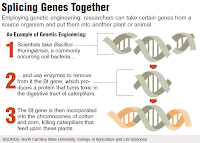Gene splicing is the removal of
introns (intervening sequences) from the primary trascript of a discontinuous
gene during the process of Transcription.
Gene splicing is the process of chemically cutting DNA in order to add bases to the DNA strand. The DNA is cut using special chemicals called restriction enzymes, which there are thousands of, and each one has its own, unique and specific code of DNA that it can cut.
Gene splicing is the process of chemically cutting DNA in order to add bases to the DNA strand. The DNA is cut using special chemicals called restriction enzymes, which there are thousands of, and each one has its own, unique and specific code of DNA that it can cut.
Why does gene splicing work?
Gene splicing is a post-transcriptional modification in which a single gene can
code for multiple proteins. Gene Splicing is done in eukaryotes, prior to mRNA
translation, by the differential inclusion or exclusion of regions of pre-mRNA.
Gene splicing is an important source of protein diversity. During a typical
gene splicing event, the pre-mRNA transcribed from one gene can lead to
different mature mRNA molecules that generate multiple functional proteins.
Thus, gene splicing enables a single gene to increase its coding capacity,
allowing the synthesis of protein isoforms that are structurally and
functionally distinct. Gene splicing is observed in high proportion of genes.
In human cells, about 40-60% of the genes are known to exhibit alternative
splicing.
Why was gene splicing done?
In natural conditin in a eukaryotic
cell it is done so as to remove the gene part which does not code for any
protein and are called exons and to join the rest parts which are known as
introns so as to make gene more specific and meaningfull In laboratory
condition it is done to insert a new type of gene in other organism by means of
plasmid or other method
It has the potential to cure genetic
diseases. Curing a disease is more economical that treating it for long period
of time.
What are the advantages of gene splicing?
Gene splicing involves removing a specific gene from one plant to
putting it into the DNA of another, transferring the characteristic of
one plant to the other. This technology has been a lot less
controversial than eugenics and cloning, because so far it has only been
attempted with plants. The benefits of this scientific advance are
clearly documented in the developing world.
What are the disadvantages of gene splicing?
Some disadvantages of Gene Splicing,
is that we spend about 40 million every year on it, when we could be spending
it in schools. Teachers are being laid off by the dozens, because of the
economic downfall, while, that much money is being spent on Gene splicing.
How is gene-splicing accomplished?
Gene Splicing Mechanism In natural
condition in eukaryotic cells:
There are several types of common gene splicing events. These are the events that can simultaneously occur in the genes after the mRNA is formed from the transcription step of the central dogma of molecular biology.
Exon Skipping: This is the most common known gene splicing mechanism in
which exon(s) are included or excluded from the final gene transcript leading
to extended or shortened mRNA variants. The exons are the coding regions of a
gene and are responsible for producing proteins that are utilized in various
cell types for a number of functions.There are several types of common gene splicing events. These are the events that can simultaneously occur in the genes after the mRNA is formed from the transcription step of the central dogma of molecular biology.
Intron Retention: An event in which an intron is retained in the final
transcript. In humans 2-5 % of the genes have been reported to retain introns.
The gene splicing mechanism retains the non-coding (junk) portions of the gene and
leads to a demornity in the protein structure and functionality.
Alternative 3' splice site and 5' splice site: Alternative gene splicing includes joining of different 5' and 3' splice site. In this kind of gene splicing, two or more alternative 5' splice site compete for joining to two or more alternate 3' splice site
Alternative 3' splice site and 5' splice site: Alternative gene splicing includes joining of different 5' and 3' splice site. In this kind of gene splicing, two or more alternative 5' splice site compete for joining to two or more alternate 3' splice site
Gene therapy replaces the faulty gene with what?
They diactivate a virous that
attacks genes and plant a healthy gene it the virous then in plant the virous
in the child or adult they ither use a needle and put it strait in the body or
cover it in fat an then you have to injest it.
to be able to replace or supplement
the defective gene with a normal allele
Source : http://wiki.answers.com/Q/What_is_gene_splicing




I'm thank you so much to the scientists which can research about gene splicing. cause that can give more the knowledge for us, especially in biology. from the the research the gene splicing has advantages and disadvantages. so, in my opinion the gen splicing can only use to the benefit. don't use to the disadvantages. if in the gen terapy, i think that is very expensive.
BalasHapus